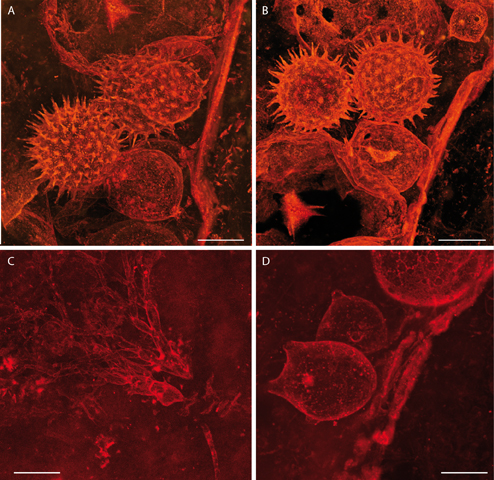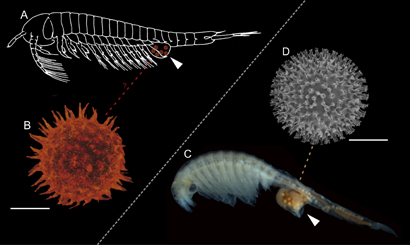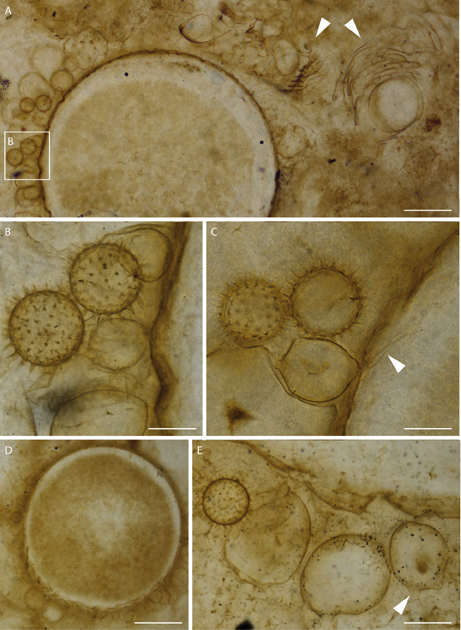Exploring a Microscopic World 407 Million Years Old
Very often, it is the news about giant prehistoric animals that grab all the attention from the media. Dinosaurs, Woolly Mammoths, pterosaurs and monstrous fish such as prehistoric sharks, get all the headlines, but today, we want to highlight a new paper published in the online, open access journal PLoS One, a paper that looks at the discovery of an exquisitely preserved fungus found in association with the minute eggs of a prehistoric freshwater crustacean.
The Rhynie Chert Lagerstätte
This freshwater fungus, lived far earlier in the history of our planet than any hominin, Woolly Mammoth, pterosaur or member of the Dinosauria for that matter. In fact, this newly discovered species of fungus, a fungus that helped to breakdown freshwater plant matter, thrived at around the same time as the very first sharks.
A High Magnification View of the New Species of Fungus
Picture credit: PLoS One
The fossils were discovered by a team of international scientists which included researchers from the Natural History Museum (London), the University of Copenhagen and the University of Maine. The team analysed microscopic slices of Rhynie Chert from Aberdeenshire, Scotland. The chert represents sedimentary deposits formed when volcanic material from hydrothermal vents periodically erupted and covered an area that featured a braided river channel and an alluvial flood plain. These hot, viscose fluids preserved both primitive terrestrial and freshwater ecosystems, providing a window into the life that existed in both these types of habitat in the Early Devonian.
Various types of fungi have been identified in the Rhynie Chert, this Lagerstätte has provided palaeontologists with evidence of fungal parasitism and symbiosis with early land plants and algae.
Fossils of the earliest freshwater branchiopod crustaceans (fairy shrimps and their close relatives), have also been discovered.
Cultoraquaticus trewini
The new species has been named Cultoraquaticus trewini, the genus name refers to the aquatic habitat of the fungus. The specific epithet honours Professor Nigel Trewin (University of Aberdeen), for his contribution to the understanding of the geology of the Rhynie Chert.
The fungus has been attributed to the Phylum Chytridiomycota, based on its internal structure, the associated papillae and its size. The exquisite preservation of this 407-million-year-old fossil has enabled scientists to assess this ancient species’ resemblance to extant fungi. It seems that these fungi were a parasite of algae and primitive prehistoric freshwater plants. The tiny, spiked structures seen in the photograph above (B, C and E) are (most likely), the eggs of the Early Devonian freshwater shrimp Lepidocaris rhyniensis.
Laser Scans Show the Fungus and the Eggs of the Early Devonian Crustacean (L. rhyniensis)

Confocal laser scanning images of resting eggs of Lepidocaris and of the fungus Cultoraquaticus trewini.
Picture credit: PLoS One
The tiny, rounded and very spiky eggs of Lepidocaris reaffirm the idea that ancient branchiopods adapted to freshwater environments early in the Devonian.
Comparison Between Lepidocaris (Extinct) and Linderiella (Extant)

Lepidocaris rhyniensis (A) and its resting egg (B) compared to modern anostracean Linderiella occidentalis (C) and resting egg of Linderiella santarosae (D). Brood pouch is indicated by an arrow. Scale bars represent 20 μm in (B) and 95 μm in (D).
Picture credit: PLoS One
The Earliest Eggs of the Branchiopoda
Although the research team cannot be one hundred percent certain that the tiny, spiky shapes are the eggs of Lepidocaris, they have made this conclusion based on the fact that L. rhyniensis fossil remains, including individuals at various growth stages, are relatively abundant in the Rhynie Chert deposits. The fossils closely resembles the egg cysts of various members of Anostraca (fairy shrimps) and they, most probably, represent the earliest eggs of freshwater branchiopods discovered to date.
Sometimes, micro-fossils are not given the prominence they deserve in the mainstream media. We praise the efforts of the research team for providing more information on the remarkable Rhynie Chert Lagerstätte and for identifying a new fungal/plant matter interaction that helped in the breakdown and mobilisation of nutrients in early freshwater food webs.
The scientific paper: “A New Chytridiomycete Fungus Intermixed with Crustacean Resting Eggs in a 407-Million-Year-Old Continental Freshwater Environment” published in PLoS One.
The Everything Dinosaur website: The Everything Dinosaur Website.







[…] Visit another Blog with some really good images from the Rhynie Chert relating to Christine’s work. […]